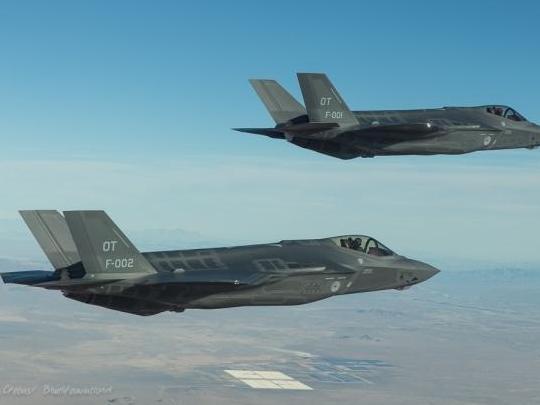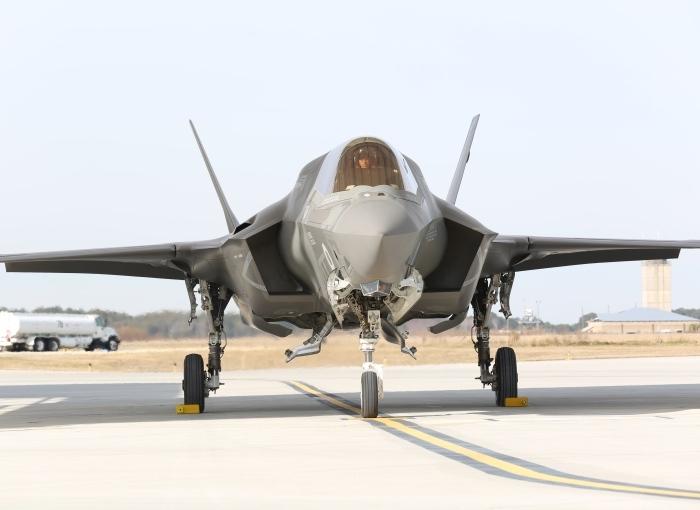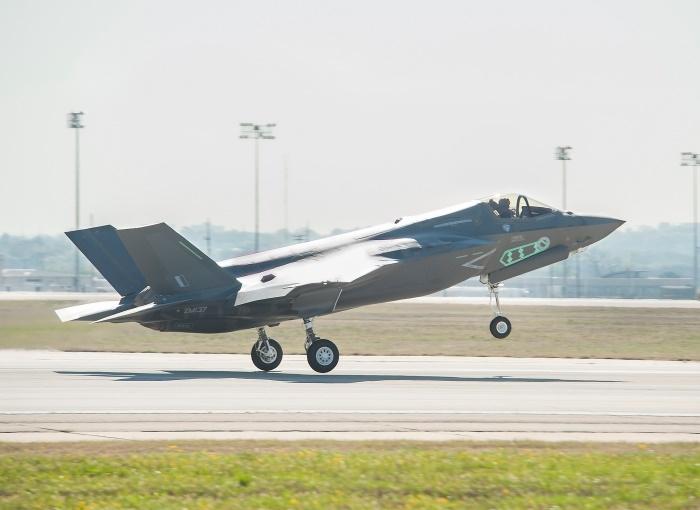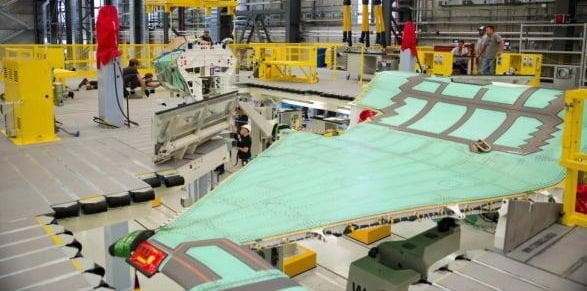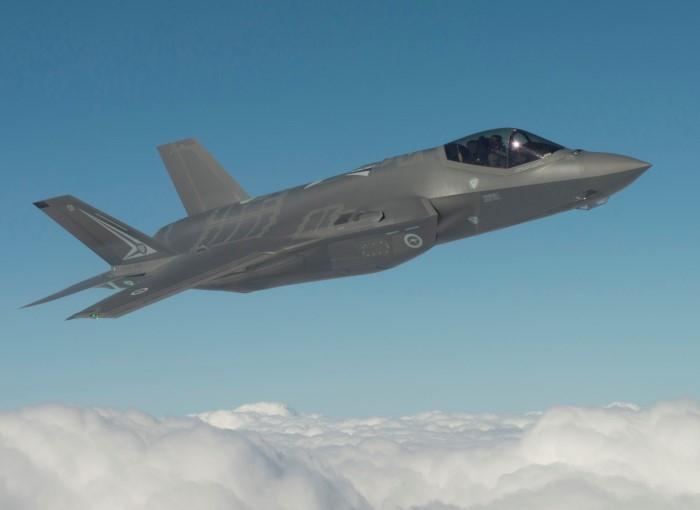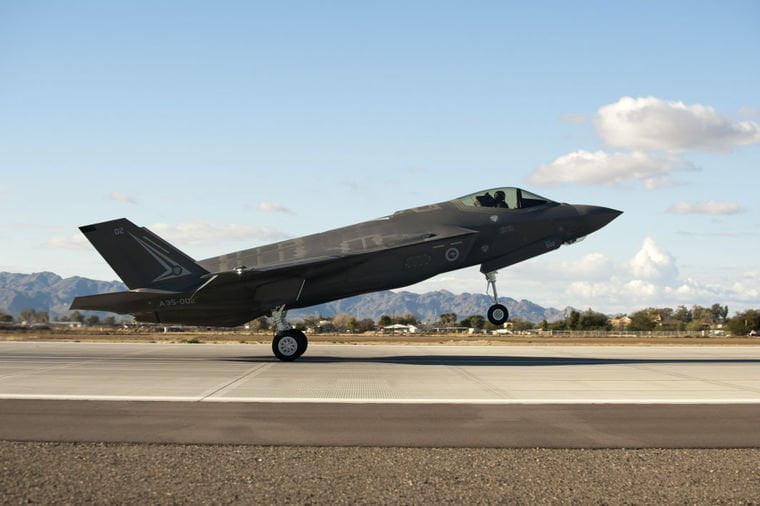2015-02-16 Australia, Italy, the UK, the Netherlands and Norway are all hitting new milestones as the F-35 comes closer to entering their combat forces.
Australia, the Netherlands and the Italians will all train at Luke AFB with the Aussies being the first to arrive, the Dutch next month and the Italians at the end of the year.
The British are training with the Marines at Beaufort Marine Corps Air Station and their first plane has arrived their already with operational testing going on in Edwards.
And the first Norwegian F-35A is being assembled at Fort Worth, and will be delivered in the Fall of this year.
Australia
Australia is flying its first F-35As at Luke AFB and training with the USAF at Luke.
The training is fully integrated with the USAF flying training sorties with the Australian aircraft.
Later this month at the Avalon Air Show, Air Marshal Brown, will unveil the RAAF’s transformation strategy leveraging the F-35s.
In a story published on the Australian MOD website on January 26. 2015:
The introduction of Australia’s 72 F-35A Lightning II aircraft into RAAF service is about to move a step closer tomorrow when the first Australian pilot commences training. Squadron Leader Andrew Jackson, Australia’s first F-35A pilot, will commence training for his first F-35A flight at Eglin Air Force Base, Florida.
The F-35A will be Australia’s first fifth-generation aircraft and will provide the RAAF with a leading air combat capability. I’m excited to be given the opportunity to take a leading role in its introduction,” SQNLDR Jackson said.
SQNLDR Jackson will undergo an intensive training program before he takes his first flight in the coming months.
“The fifth generation F-35A capabilities represent a quantum shift over legacy fighters. I am looking forward to the training challenge it will present.This aircraft will give fighter pilots a level of situational awareness that far exceeds legacy platforms. Experiencing this level of capability first hand is something every pilot dreams of,” he said.
SQNLDR Jackson will have an important future role as an Instructor Pilot for Australian and international F-35A pilots, and was selected for his operational flying skills, extensive experience and leadership.
“It will be a great honor to work and train alongside the United States and other international Air Force pilots,” SQNLDR Jackson said.
The second Australian F-35A pilot, SQNLDR David Bell, will begin his training in mid-2015. SQNLDR Bell is a qualified Test Pilot.
The F-35A (commonly known as the Joint Strike Fighter) will meet Australia’s future air combat and strike needs, providing a networked force-multiplier effect in terms of situational awareness and combat effectiveness.
The F-35A’s combination of stealth, advanced sensors, networking and data fusion capabilities, when integrated with other defense systems, will enable the RAAF to maintain an air combat edge.
The first F-35A aircraft will arrive in Australia at the end of 2018 with the first operational squadron to be established by 2020. The F-35A will replace the aging F/A-18A/B Hornets at RAAF Bases Williamtown (NSW) and Tindal (NT).
The Netherlands
Two F-35As for the Royal Netherlands Air Force landed at Edwards Air Force Base, California, Jan. 16, after a five-hour flight from Eglin Air Force Base, Florida.
The jets will perform operational test and evaluations at Edwards.
The Dutch have moved from Eglin to Edwards AFB to complete their developmental testing and then will join the USAF and the RAAF at Luke AFB for pilot training later this year.
And in late 2014, the Royal Netherlands Air Force changed to command of its F-35 detachment at Eglin AFB to 323 Squadron.
According to an article by Anno Gravermaker published on November 11, 2014 in Flight International:
Now re-established in the USA, 323 Sqn will be tasked primarily with conducting initial operational test and evaluation (IOT&E) of the F-35, following its relocation to Edwards AFB in California by the end of this year.
The Dutch air force has taken delivery of two conventional take-off and landing F-35As to support the US-led IOT&E activity, and has three pilots qualified on the type.
The F-35A is due to become operational with the Royal Netherlands Air Force during 2019, with the service expected to eventually receive another 37 of the type.
Italy
Italian jets are being assembled at the FACO in Cameri with the first jets coming off the line later this year.
The Italian jets will later this year fly to Luke AFB and become the third international partner training at Luke AFB.
And Cameri has been selected by the US DoD as a major maintenance facility for the F-35 in Europe.
Italy invested nearly $1 billion in building” the Cameri facility in northern Italy “and it’s very hard, on a cost basis and value basis, to match that,” F-35 program manager Air Force Lieutenant General Christopher Bogdan told reporters in Washington today. “Italy is a stable and very important partner.”
Italian Defense Minister Roberta Pinotti has been pushing for a bigger role in maintenance and had discussed the deal with U.S. officials in Washington this year. The deal confirms Italy’s participation in the F-35 program, even as the country is considering cuts in an order of the jets after more than a decade of economic stagnation.
“This agreement shows Italy remains deeply involved in the F-35 program,” said Michele Nones, director of the security and defense program at the Institute for International Affairs think tank in Rome. “It’s important for Italy if you consider there will be at least 500 jets in Europe in the next 15 years that will need maintenance and upgrades for another 40 years or so.”
Norway
The first Norwegian F-35As are being assembled at the Final Assembly Line in Fort Worth and will be delivered to Norway in the Fall.
“We are pleased and excited to see our first aircraft taking shape as planned,” said Mr. Øystein Bø, State Secretary with the Norwegian Ministry of Defense. “Together with the Norwegian-developed Joint Strike Missile the F-35 will be one of the core capabilities of our future defense structure, representing a significant increase in our combat capabilities.”
The global supply chain for the F-35 currently has seven Norwegian companies under contract building parts for the F-35. Norwegian industry is expected to gain up to $4.7billion USD in industry opportunities over the life of the F-35 program. Every F-35 built will have Norwegian parts and components.
And the Norwegians will then modify their F-35As to augment their capability to operate in the Arctic.
According to an article by Dan Parsons published August 22. 2014 in Flight International:
When Norway’s fleet of Lockheed Martin F-35As comes online in 2015, there will be little to distinguish them from jets belonging to the United States and other program partners.
That will change after 2017, when the Scandinavian nation will be the first to receive a modular kit to equip its jets with drag chutes that help the aircraft land on icy Arctic runways.
The chute, which the Netherlands and Canada also are eyeing as a modification to their F-35s, is the first aftermarket modification to the jets through seven low-rate initial production (LRIP) lots.
Norway will take delivery of its first F-35A in 2015, but testing on the chute will not begin for another two years.
Until then, the Norwegians will train in the United States with “clean,” unmodified aircraft, Suku Kurien, Lockheed’s F-35 drag chute program manager, tells Flightglobal.
Norway’s first jets – included in LRIPs 7 and 8 ‑ will be equipped with Lockheed’s Block 2B software configuration, which does not include the capability to deploy an arresting chute. Norwegian pilots still will train with the aircraft at Luke Air Force Base in Arizona.
The necessary hardware modifications, including airframe reinforcements, are being performed on planes in the current LRIP 7 and 8, which Lockheed and the US government are negotiating.
The Block 3F software that will allow for chute deployment, will be the standard configuration for all aircraft in LRIP lots 9 and beyond, Kurien says.
The UK
The Royal Air Force has begun operational testing of their F-35Bs at Edwards AFB.
17 (Reserve) Squadron has begun operational testing of the UK’s first F-35B, 100 years after the unit was first established.
The squadron, which was first formed in 1915, will be responsible for all the test and evaluation of the UK’s first F-35 Lightning II.
The aircraft, known as BK-1, is stationed at Edwards Air Force Base in California and will be operated under UK regulations. Personnel from 17 (R) Sqn, which is made up of engineers and pilots from the RAF and Royal Navy, will fly and maintain the jets independently from their US colleagues – an important step towards the UK developing its Joint Strike Fighter capability.
A parade and flypast to mark the centenary and their new role with the F-35 Lightning II will be held at Edwards AFB today. Chief of the Air Staff, Air Chief Marshal Sir Andrew Pulford will attend, along with representatives from some of the UK companies involved in the manufacturing of the F-35.
Chief of the Air Staff, Air Chief Marshal Sir Andrew Pulford, said:
“Today is an important day for both the Royal Air Force and the Royal Navy. The start of UK operational testing on the Lightning II aircraft is a significant milestone for us; although our relationship with the United States as partners on the Joint Strike Fighter Programme remains as strong as ever. Our collaboration with the US Armed Forces on the world’s largest and most advanced defence project is a clear demonstration of our enduring close military partnership with the United States.
“I am delighted to be here at Edwards Air Force Base today to celebrate the centenary of Number 17 (R) Squadron. Their new role in developing and testing the UK’s fifth generation fighter aircraft will be an exciting new chapter in the Squadron’s rich and proud history.”
Over the last 100 years, 17 (R) Sqn has seen action in Egypt, Burma and Japan and the Squadron has previously flown Hurricanes, Spitfires and Tornados.Now the Squadron is flying the F-35 Lightning II, a multi-role stealth aircraft capable of undertaking a wide range of operations from land and sea. Equipped with an array of advanced sensors, highly integrated mission systems and air to air and air to ground weapons, the aircraft will provide the RAF and Royal Navy with fifth generation capability from 2018.
Commanding Officer of 17 (R) Squadron, Wing Commander James Beck, said:
“For a pilot, it’s a dream come true to fly from Edwards Air Force Base. It’s where Chuck Yeager flew from and now we’re the first nation outside of America to flythe F35 independently under our own regulations.”
Petty Officer Gary Lister has served for 28 years in the Royal Navy, and is responsible for maintaining the ejection seats and crew escape system, as well as managing the weapons on the aircraft. Petty Officer Lister commented:
“The F-35 has a myriad of sensors and technologies which means every aspect of the aircraft is constantly being tested. This means when snags are found, they aren’t just fixed, but analysed and scrutinised to help future fault diagnosis and streamline the maintenance effort; it’s a hugely complex aircraft which will give both the navy and the RAF a superb capability”
While testing and evaluation of BK-1 is underway at Edwards Air Force Base, over 2000 miles away at Marine Corps Air Station Beaufort in South Carolina, the first aircraft that will be used operationally – BK-3 – has just arrived.
Working alongside US Marine Corps colleagues, UK personnel will fly BK-3, which will form part of the UK’s first front-line Lightning II unit, 617 Squadron, operating from RAF Marham and then Royal Navy’s new Queen Elizabeth Class Carriers from 2018.
The RAF will be training with the Marines at Marine Corps Air Station Beaufort and the first UK F-35B arrived their on February 3, 2015.
Marine Fighter Attack Training Squadron 501 welcomed the first United Kingdom F-35B Lightning II Joint Strike Fighter aboard Marine Corps Air Station Beaufort, Feb. 3.
In a story by Pfc. Samantha Torres, the arrival of the Brits to Beaufort was highlighted in a story published February 3, 2015.
The jet was flown by British Royal Air Force pilot Hugh Nichols, the UK senior national representative from Eglin Air Force Base, Florida.
“It’s big for the Air Station, the town, and the pilot training center,” said Lt. Col. Joseph T. Bachmann, the commanding officer of VMFAT-501.
The jet is one of only three British F-35B aircraft and is assigned to VMFAT-501.
The international cooperation of VMFAT-501 and the RAF has a huge impact on the Air Station and the Marine Corps as a whole.
“This is another example of the Marine Corps and the UK working hand in hand to achieve great things with the F-35,” said Bachmann.
The F-35B will replace the Marine Corps’ aging legacy tactical fleet. In addition to replacing the F/A-18A-D Hornet, the F-35B will replace the AV-8B Harrier and EA-6B Prowler, essentially necking down to one common tactical fixed-wing aircraft and providing the dominant, multi-role, fifth-generation capabilities needed across the full spectrum of combat operations to deter potential adversaries and enable future naval aviation power projection.
According to Lockheed Martin, the Lightning II will also be the backbone of Britain’s future carrier operations.
This is the last F-35B delivered from Eglin, turning a page in the next chapter for the program.
“The international cooperation is going to be huge for the next few years,” said Nichols. “The fact that we are working with VMFAT-501 is already a big deal and we are setting the scene for the next few years.”
Lieutenant Commander Beth Kitchen, the UK senior engineering officer at VMFAT-501, ensures that the aircraft is maintained and the UK is able to develop its own engineering maintenance and air competency in order to independently operate the aircraft.
The F-35 is the UKs future maritime strike ground attack fighter aircraft.
“The fact that we can operate from VMFAT-501 for the next couple years means we will be ahead of the game when it comes to developing our own capabilities back on UK soil come 2018,” said Kitchen.
For our Special Reports on the partners and the evolution of air combat see the following:
EUROPEAN DEFENSE, THE ARCTIC AND THE FUTURE
In this Special Report, Second Line of Defense looks at the evolving defense and security situation in the Baltics and in the Arctic. Russian actions in Crimea have returned direct defense to the European agenda, a fact not missed by the Northern European powers and the Baltic states.
Put bluntly, one Danish leader underscored:
The Ukraine situation has in fact put emphasis to our own region after having the luxury I would say for maybe ten or fifteen years to see security issues as largely being about national interests in a global setting such as in Afghanistan, Libya or wherever and now suddenly it is not as much a matter of national interest, it is actually a matter of national defense.
This report is divided into three parts in examining the dynamics of change in the region.
The first part is based on interviews conducted in Denmark in May 2014 and provides Danish perspectives on the evolving defense and security situation in their neighborhood.
The second part examines how the Crimean crisis is affecting broader global relations, and the direct defense of Europe, in particular.
The third part then focuses upon the Arctic opening and ways the developmental, safety and security dimensions intersect with Arctic defense.
Russian map making is having its impact on Northern Europe. This report focuses on some aspects of that impact.
https://sldinfo.com/european-defense-the-arctic-and-the-future/
AUSTRALIAN DEFENSE MODERNIZATION: SHAPING CAPABILITIES FOR 21ST CENTURY OPERATIONS
In this special report, Second Line of Defense looks at Australian defense modernization, notably in the air systems areas. The report is informed by a number of interviews conducted in Australia in March 2014. It is informed as well by interviews with USN, USMC, and USAF staff and commanders.
The report highlights the importance of cross cutting modernizations among allies in the region, which can be crafted into a multi-faceted and multi-dimensional deterrence in depth strategy for the US, and its allies.
After taking an overview on Australian developments (with a look at Japan as well), the report examines the following four topics: the key building blocks of Australian defense modernization; the impact of the coming of the F-35 on that modernization; the evolution of Australian defense industry associated with the modernization process; and finally the perspectives of MARFORPAC and PACAF on those modernizations and the challenge and opportunities inherent in cross-cutting modernization.
We conclude by highlighting the central significance of joint and coalition training for shaping an effective Pacific defense capability and strategy.
Covering a territory which covers so much of the earth’s surface and with thousands of islands present a tapestry of operational complexity. This is no place for amateurs.
As Admiral Nimitz confronted the last century’s challenges he concluded a core lesson for this century’s Pacific warriors: “Having confronted the Imperial Japanese Navy’s skill, energy, persistence, and courage, Nimitz identified the key to victory: ‘training, TRAINING and M-O-R-E T-R-A-I-N-I-N-G.”
The US and its core allies are shaping new capabilities to deal with the various threats and challenges in the Pacific in the time of the Asian century. Flexibility in operations and agility in inserting force with a proper calibration of effect will be enhanced as new systems come on line in the years ahead but joint and coalition training become more essential as new approaches and capabilities are forged.
CAMERI, ITALY AND THE F-35: SPECIAL REPORT (ENGLISH AND ITALIAN VERSIONS)
In this special report, we look at the Italian engagement with the F-35 and the thinking of Italian airpower leaders about the impact of the F-35 on the future.
As of January 2014, we have a version in Italian for our Italian readers which can be downloaded below:
Italian F-35 Special Report Italian Edition January 2014
At Cameri, Italians are standing up a Final Assembly and Check Out Facility or FACO, a Final Wing Assembly for building for the global fleet, and Fleet Sustainment Facility for the region, including Europe, the Mediterranean and the Middle East.
The Cameri facility includes both an ATF or Aircraft Test Facility (for testing stealth performance) and a final paint facility. This means that in the heart of Europe, the F-35 fleet will have a battle damage facility.
Cameri, Fort Worth, Japan and Israel will all see key elements of the F-35 global production system. This means that for the first time, the United States in building its front line fighter is looking to work differently with allies. In turn, allies are building out a global sustainment capability available to those nations, which buy, into the F-35 fleet.
Significant cross learning has already occurred, but is just beginning. The advantages of building a global system where best practices can be developed are obvious.
Building a global sustainment approach is less so. But the impact on the cost of operations of an airfleet is significant.
Rather than bringing the logistical support equipment and material to the operational forward base, the forward deployment of warehoused parts and regionally based sustainment competencies will not only allow and air fleet to move rapidly to a problem but to reduce the need for surge airlift and tanking to get those supplies to the point of attack.
This is part of what the head of the Italian Air Force refers to the F-35 as part of building new coalition capabilities and shaping an F-35 fleet which can operate through coalitions against distributed challenges with distributed operational capabilities.
We start the Special Report by providing the interviews with RADM Covella, the head of the F-35 program in Italy, Lt. General Preziosa, the head of the Italian Air Force, BG Espisoto and Lt General Lupoli who focused on their perspectives on the F-35 and the evolution of Italian airpower.
We next add a look at the impact of the new aircraft on the latest Italian aircraft carrier, the Cavour. What is the impact of shifting from Harriers to F-35Bs on the role of this type of ship?
We next examine the perspectives of four key industrial executives working in Italy with Alenia Aermacchi (AAeM) to make Cameri a reality. Their experience and perspectives are unique and are part of a new approach to Euro-American defense industrial cooperation.
We then close with two more general pieces providing overviews.
The first looks at the nature of change posed by the Italian experience for the Asians as the Japanese add their own FACO facility.
The second looks at the general approach of the F-35 program to allies and the role of global investments.
It is the case of a 21st century combat aircraft built in global 21st century facilities with a global sustainment approach built in.
This is a unique moment in military aviation history.
https://sldinfo.com/cameri-italy-and-the-f-35-special-report/
The slideshow above shows various partner F-35 planes in process.
The first two showAustralian F-35As.
The third shows Dutch F-35As.
The fourth shows the FACO at Cameri assembling an Italian F-35A.
The fifth photo shows the first Norwegian F-35A being assembled at Fort Worth.
The final photos show the UK F-35Bs at Edwards and Beaufort MCAS.
Credit Photos: Australian MOD, Lockheed Martin, Finmeccanica, the UK MOD and the Norwegian MOD.


